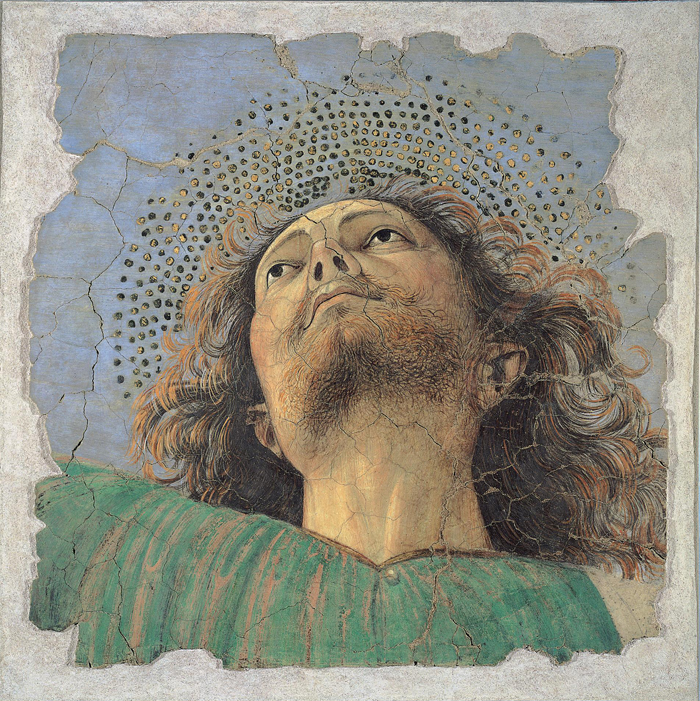 |
||||||||||||||||||||
 |
||||||||||||||||||||
|
No firm documentary evidence exists to help us establish the exact date of the Dead Christ, nor we know details of whom it was painted for or where it was to be found for decades, though we know it was in Mantegna's studio on the time of his death. It has been suggested that Mantegna intended it for his own tomb in the church of Sant'Andrea in Mantua (Boorsch, 1992). It bears many stylistic affinities with the artist's Camera degli Sposi (Camera Picta) in the Ducal Palace at Mantua (1468-72). On the other hand, it also has similarities with Mantegna's St. Sebastian, which would mean that the Dead Christ could also have been painted after 1480. A sketch of a man reclining on a stone slab, in the British Museum in London and dating from around 1470, seems to have been a preparatory sketch for Mantegna's Dead Christ, suggesting that the painting may have been done between the 1470 and the 1474. Dating the painting in these years would provide support to the thesis that it had inspired some other examples of lamentations.
We actually never even really know the exact title of the painting. Art historians refer to it as Lamentation over the Dead Christ or just Dead Christ: even in the Italian Language it has been called “Compianto sul Cristo morto e le due dolenti”, “Cristo Morto” o “Cristo in Scurto”, basically just describing the subject matter of the painting. Cristo in Scurto (Christ in foreshortening) is mentioned in a letter written on October 2, 1506 to the Duke of Mantua, by the Mantegna’s son, Ludovico (Camesasca, 1981) among the works still in the artist studio at the time of his death in 1506, which may or may not be the same one. Quite certainly, Cardinal Sigismondo Gonzaga bought that painting shortly after Mantegna’s death. That the letter is genuine has never been doubted, but it is equally true that clues gleaned from the archives would seem to indicate that there were two versions of the Dead Christ. In 1531 the painting was installed in the apartments of the new Duchess Margherita Paleologa, always in the Gonzaga family. (Facchinetti, and Uccelli, 2006). And in 1626 it was still in the Palazzo Ducale, in the Camerino delle Dame (the Ladies’ Room), as the inventory tells us (Zeri, 1990). But in 1626 a picture conforming in all respect to the Brera Dead Christ is listed in the Aldobrandini collection. The 1665 Aldobrabdini’s inventory specifies that the Dead Christ was painted on a canvas mounted on a panel. The painting can be traced there in guidebooks until the late 18th century. Questions about the life of this painting finds finally some answers thanks to the catalog of the Brera Pinacoteque by Federico Zeri (1990), who citing the study by R. Lightbrown reveals that the painting went from Mantua to Rome at Cardinal Mazzarino’s Palazzo, then to Camillo Pamphili (Olimpia Aldobrandini’s second husband), and eventually to King Louis XIV in France. Giuseppe Bossi (a neoclassic Italian painter) bought the painting on March 21st 1807 from Louis XIV heirs. There have been a lot of difficulties connected to the exportation of the paint, but finally in 1807 a box concealing the Dead Christ filled under close supervision of Antonio Canova was shipped to Bossi, in all likelihood with the original glass to protect the canvas *. The glass was functional in order to warm the dark color pallet of the delicate glue tempera used for the paint (Facchinetti, and Uccelli, 2006). The Painting in the Aldobrandini Inventory, the other Lamentation, was instead a completely different painting: first of all it was painted on wood and it was in a vertical format. We don’t have any other information about this last wood panel, which is still missing. * Bossi cites the glass in a letter to Canova on December 16th 1806 “This is the moment where you can give me the privilege to receive my beloved Mantegna. If you think it will arrive to me without any damages, please include that glass whose color helps the paint so much”. |

 For example, in the 1475 fresco by Melozzo da Forli’ (fig. 1), the figure of the green apostle show great similarities with the Christ of Mantegna. A copy of the painting of the Dead Christ in the De Navarro Collection (Glen Head, New York) complicates the story even further.
For example, in the 1475 fresco by Melozzo da Forli’ (fig. 1), the figure of the green apostle show great similarities with the Christ of Mantegna. A copy of the painting of the Dead Christ in the De Navarro Collection (Glen Head, New York) complicates the story even further.